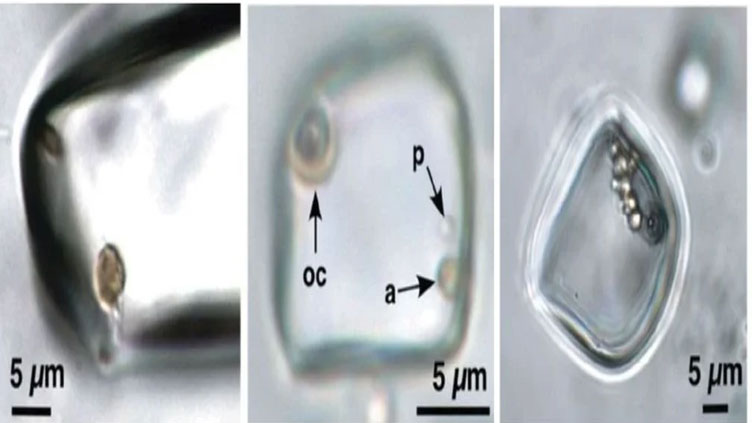Potentially alive 830-million-year-old organisms found trapped in ancient rock

WeirdNews
Potentially alive 830-million-year-old organisms found trapped in ancient rock
(Web Desk) - An incredible discovery has just revealed a potential new source for understanding life on ancient Earth.
A team of geologists has just discovered tiny remnants of prokaryotic and algal life – trapped inside crystals of halite dating back to 830 million years ago.
Halite is sodium chloride, also known as rock salt, and the discovery suggests that this natural mineral could be a previously untapped resource for studying ancient saltwater environments.
Moreover, the organisms trapped therein may still be alive.
The extraordinary study also has implications for the search for ancient life, not just on Earth, but in extraterrestrial environments, such as Mars, where large salt deposits have been identified as evidence of ancient, large-scale liquid water reservoirs.
The organisms don t look like you might be expecting. Previous ancient microfossils have been found pressed into rock formations, such as shale, dating back billions of years. Salt is not able to preserve organic material in the same way.
Instead, when the crystals are forming in a saltwater environment, small amounts of fluid can be trapped inside. These are called fluid inclusions, and they re remnants of the parent waters from which the halite crystallized.
This makes them scientifically valuable, since they can contain information about the water temperature, water chemistry and even atmospheric temperature at the time the mineral formed.
Scientists have also found microorganisms living in recent and modern environments where halite forms. These environments are extremely salty; nevertheless, microorganisms such as bacteria, fungi and algae have all been found thriving in them.
In addition, microorganisms have been documented in fluid inclusions in gypsum and halite, mostly modern or recent, with a handful dating back to ancient times. However, the method of identifying these ancient organisms has left some doubt as to whether they are the same age as the halite.
"Therefore, a question has persisted amongst geomicrobiologists," wrote a team led by geologist Sara Schreder-Gomes of West Virginia University. "What are the oldest chemical sedimentary rocks that contain prokaryotic and eukaryotic microorganisms from the depositional environment?"
The middle of Australia is desert now, but it was once an ancient salty sea. The Browne Formation is a well-characterized and dated stratigraphic unit from central Australia, dating back to the Neoproterozoic. It includes extensive halite, indicative of an ancient marine environment.
Using a core sample from the Browne Formation extracted by the Geological Survey of Western Australia in 1997, Schreder-Gomes and her colleagues were able to conduct investigations of unaltered Neoproterozoic halite using nothing but non-invasive optical methods. This left the halite intact; which, importantly, means that anything inside had to have been trapped at the time the crystals formed.
They used transmitted-light and ultraviolet petrography, first at low magnification to identify halite crystals, then at up to 2,000x magnification to study the fluid inclusions therein.
Inside, they found organic solids and liquids, consistent with prokaryotic and eukaryotic cells, based on their size, shape and ultraviolet fluorescence.
The range of fluorescence was interesting, too. Some of the samples showed colors consistent with organic decay, while others demonstrated the same fluorescence of modern organisms, suggestive, the researchers said, of unaltered organic material.
It s even possible that some of the organisms are still alive, the researchers noted. The fluid inclusions could serve as microhabitats where tiny colonies thrive. And living prokaryotes have been extracted from halite dating back 250 million years; why not 830 million?
"Possible survival of microorganisms over geologic time scales is not fully understood," the researchers wrote.
"It has been suggested that radiation would destroy organic matter over long time periods, yet Nicastro et al. (2002) found that buried 250 million-year-old halite was exposed to only negligible amounts of radiation. Additionally, microorganisms may survive in fluid inclusions by metabolic changes, including starvation survival and cyst stages, and coexistence with organic compounds or dead cells that could serve as nutrient sources."
This absolutely has implications for Mars, where deposits can be found that have similar compositions to the Browne Formation, the researchers said. Their research shows how such organisms can be identified without destroying or disrupting the samples, which could give us a new set of tools for identifying them – and better understanding Earth s own history, too.
"Optical examination should be considered a fundamental step in any study of biosignatures in ancient rocks. It allows geologic context of microorganisms to be known prior to further chemical or biological analyses … and it provides a target for such analyses," the team wrote.
"Ancient chemical sediments, both of terrestrial and extraterrestrial origin, should be considered potential hosts for ancient microorganisms and organic compounds."


